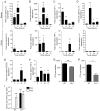Mast cell interleukin-10 drives localized tolerance in chronic bladder infection
- PMID: 23415912
- PMCID: PMC3647685
- DOI: 10.1016/j.immuni.2012.10.019
Mast cell interleukin-10 drives localized tolerance in chronic bladder infection
Abstract
The lower urinary tract's virtually inevitable exposure to external microbial pathogens warrants efficient tissue-specialized defenses to maintain sterility. The observation that the bladder can become chronically infected in combination with clinical observations that antibody responses after bladder infections are not detectable suggest defects in the formation of adaptive immunity and immunological memory. We have identified a broadly immunosuppressive transcriptional program specific to the bladder, but not the kidney, during infection of the urinary tract that is dependent on tissue-resident mast cells (MCs). This involves localized production of interleukin-10 and results in suppressed humoral and cell-mediated responses and bacterial persistence. Therefore, in addition to the previously described role of MCs orchestrating the early innate immunity during bladder infection, they subsequently play a tissue-specific immunosuppressive role. These findings may explain the prevalent recurrence of bladder infections and suggest the bladder as a site exhibiting an intrinsic degree of MC-maintained immune privilege.
Copyright © 2013 Elsevier Inc. All rights reserved.
Figures







Comment in
-
Mucosal immunology: A wee immune response.Nat Rev Immunol. 2013 Apr;13(4):220-1. doi: 10.1038/nri3426. Epub 2013 Mar 1. Nat Rev Immunol. 2013. PMID: 23449339 No abstract available.
References
-
- Abraham SN, Arock M. Mast cells and basophils in innate immunity. Seminars in immunology. 1998;10:373–381. - PubMed
Publication types
MeSH terms
Substances
Grants and funding
LinkOut - more resources
Full Text Sources
Other Literature Sources
Molecular Biology Databases

